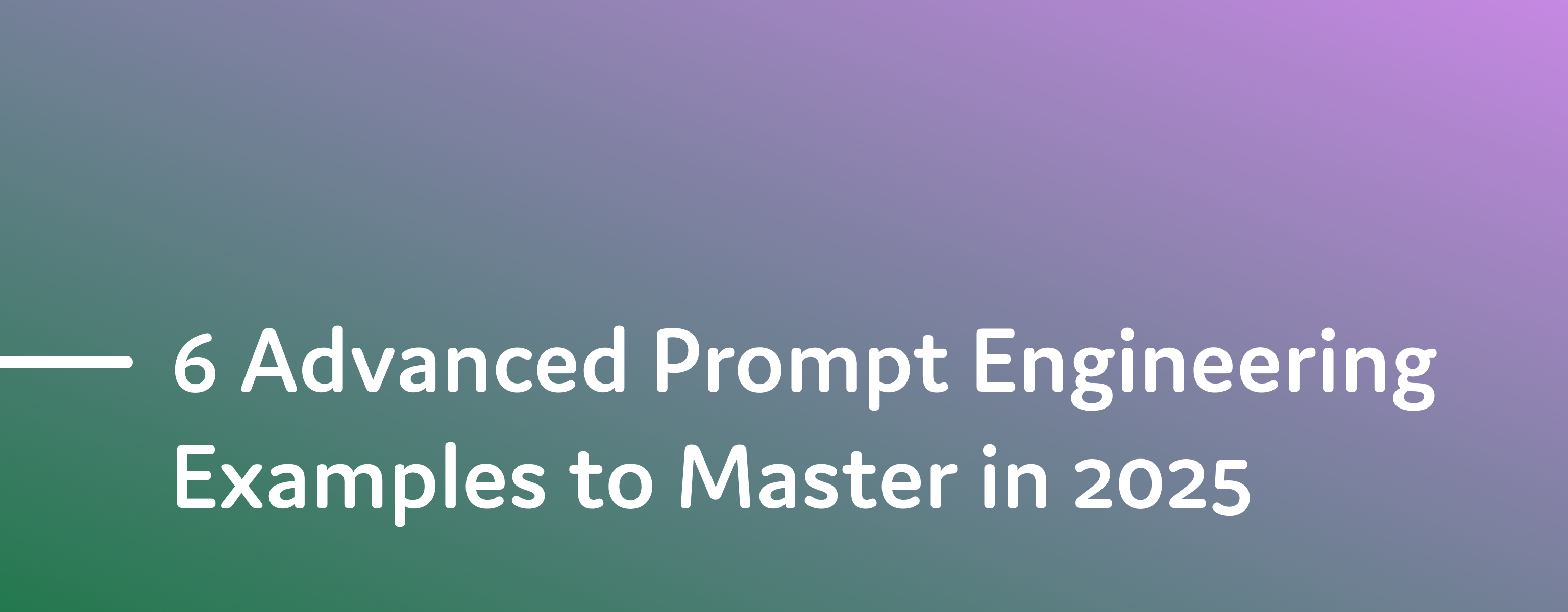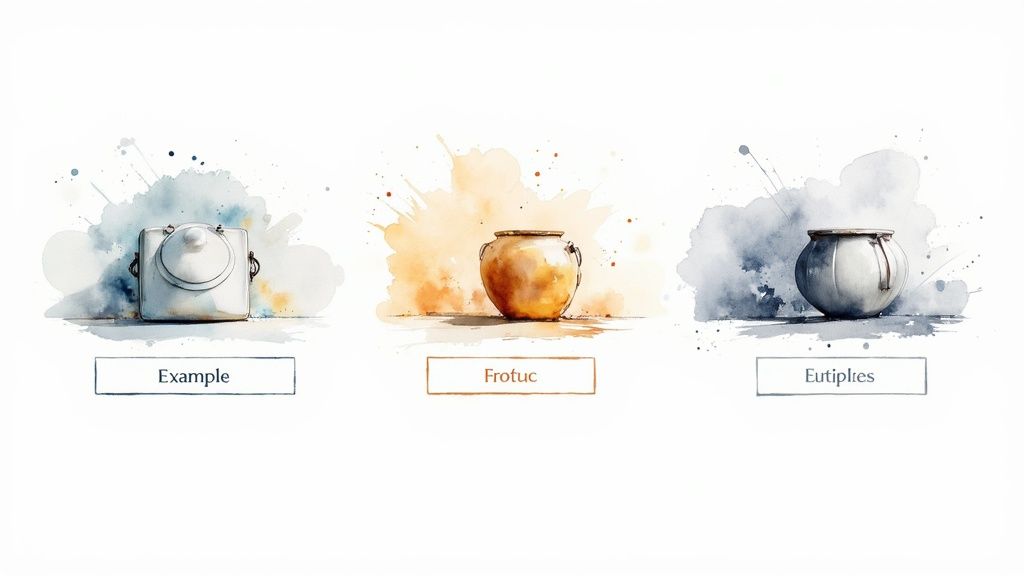6 Advanced Prompt Engineering Examples to Master in 2025

Asking an AI a basic question is easy, but getting a truly exceptional, ready-to-use response requires a more deliberate approach. Vague or simplistic inputs often lead to generic, uninspired outputs. The difference between a novice user and an expert prompt engineer lies in the ability to provide specific, structured instructions that guide the AI toward a desired outcome. This is where advanced prompt engineering techniques become essential.
This guide moves beyond simple commands to showcase six powerful prompt engineering examples that will fundamentally change how you interact with AI. We will dissect specific strategies like Chain-of-Thought (CoT), Few-Shot, and Role-Based prompting, providing a detailed breakdown of what makes each one effective. You will learn not just the "how" but the "why" behind crafting precise instructions for text, image, and even more niche creative applications. For instance, as you develop your skills, you can apply these principles to specialized fields, such as when you are looking to master mastering prompt writing for AI text sound effects.
Each example comes with a clear analysis and actionable takeaways you can implement immediately. Prepare to transform your AI-generated content from mediocre to masterful, armed with replicable methods for achieving consistent, high-quality results.
1. Chain-of-Thought (CoT) Prompting
Chain-of-Thought (CoT) prompting is a powerful technique that guides an AI to break down a complex problem into a sequence of intermediate reasoning steps. Instead of asking for a direct answer, you instruct the model to "think step by step," mimicking a human's logical thought process. This method significantly improves accuracy, especially for tasks involving arithmetic, commonsense reasoning, and symbolic logic.

The core idea, popularized by researchers at Google and OpenAI, is that forcing a model to articulate its reasoning path reduces the likelihood of it "jumping" to an incorrect conclusion. By externalizing its thought process, the model can better track dependencies and perform more reliable calculations, making it one of the most essential prompt engineering examples for complex problem-solving.
Strategic Analysis & Breakdown
The effectiveness of CoT lies in its ability to transform a difficult, multi-step problem into a series of simpler, manageable ones. This structured approach allows the model to allocate computational resources more effectively at each stage of reasoning.
- Why It Works: It encourages the model to generate a sequence of connected thoughts that build upon each other, leading to a more robust and verifiable final answer.
- Key Tactic: The magic phrase is often as simple as adding "Let's think step by step" to your prompt. This trigger activates the model's ability to structure its response logically.
- Application: Ideal for math word problems, logical puzzles, code debugging, and complex strategic analysis where the journey to the answer is as important as the destination itself.
Actionable Tips & Takeaways
To effectively implement CoT prompting, focus on clarity and structure in your instructions.
Pro Tip: Use CoT to debug the model's own "black box" reasoning. When an AI gives a strange answer, ask it to explain its reasoning step-by-step to identify where its logic went wrong.
Here are some practical tips:
- Use Trigger Phrases: Start prompts with phrases like "Work through this problem systematically" or "First, do X, then do Y, then do Z."
- Provide an Example (Few-Shot CoT): Show the model exactly what a step-by-step answer looks like. Include a simple problem with a detailed reasoning chain and the final answer.
- Break Down the Prompt: For extremely complex tasks, you can even structure your prompt to explicitly ask for sub-problems to be solved in sequence.
For those looking to go deeper into the mechanics of this method, you can find a wealth of information in our complete guide. Learn more about Mastering AI Prompt Engineering for even more advanced techniques.
2. Few-Shot Prompting
Few-Shot Prompting is a technique that involves providing the AI with a small number of examples (or "shots") of the task you want it to perform, directly within the prompt itself. Instead of just describing the task, you show the model exactly what you want by demonstrating the input-output pattern. This "in-context learning" allows the model to grasp the desired format, style, and logic without any need for complex fine-tuning.

Pioneered by researchers at OpenAI during the development of GPT-3, this method proves that large language models can learn new tasks on the fly from just a handful of examples. By including these demonstrations, you effectively guide the model's behavior, making it one of the most practical prompt engineering examples for achieving consistent and highly specific outputs, such as sentiment analysis or data extraction.
Strategic Analysis & Breakdown
The power of few-shot prompting comes from its ability to constrain the model's vast knowledge to a very specific, user-defined task. By providing clear examples, you are essentially creating a temporary, ad-hoc instruction set that the model follows for the duration of that single request.
- Why It Works: It leverages the model's pattern-matching capabilities. When the AI sees several examples of "Input A -> Output B," it learns the underlying transformation rule and applies it to your new input.
- Key Tactic: Structure your prompt with a clear, consistent format for each example (e.g.,
Input: [text],Output: [label]). This makes the pattern easy for the model to identify and replicate. - Application: Excellent for classification tasks (like email categorization), data formatting (extracting names from a paragraph), and creative generation that requires a specific style (like writing product descriptions in a certain tone).
Actionable Tips & Takeaways
To maximize the effectiveness of few-shot prompting, the quality and structure of your examples are paramount.
Pro Tip: When a model struggles with a complex instruction, switch to a few-shot prompt. Showing it what to do is often more effective than telling it, especially for nuanced tasks where descriptive words might be ambiguous.
Here are some practical tips:
- Choose Diverse Examples: Select examples that cover a range of scenarios, including potential edge cases. For sentiment analysis, include positive, negative, and neutral examples.
- Maintain Consistent Formatting: The structure of your examples should be identical. If you use "Review:" and "Sentiment:" for the first example, use the same labels for all others.
- Keep Examples Concise: Your examples should be clear and to the point. They need to demonstrate the task without adding unnecessary information that could confuse the model.
For those looking to explore more advanced ways to guide AI, a deeper understanding of various prompting methods is key. Learn more about Mastering AI Prompt Engineering to elevate your skills.
3. Role-Based Prompting
Role-Based Prompting, also known as persona prompting, involves assigning a specific role, identity, or expertise to the AI model within your prompt. By instructing the model to act as an expert in a particular field, you guide it to adopt the tone, vocabulary, and knowledge base associated with that persona, leading to more specialized and contextually appropriate responses.

The underlying principle is that by framing the AI as a specialist, such as a "senior financial advisor" or "professional editor," you constrain its output to a more useful and relevant domain. This technique, widely adopted by the ChatGPT community and AI training specialists, is one of the most effective prompt engineering examples for elevating the quality and authority of AI-generated content.
Strategic Analysis & Breakdown
The power of Role-Based Prompting comes from its ability to activate specific clusters of knowledge within the model's vast training data. Assigning a persona helps the AI filter out generic information and focus on the language and concepts relevant to the designated role, producing more nuanced and expert-level output.
- Why It Works: It transforms the AI from a general-purpose tool into a specialized consultant. This focused context minimizes ambiguity and aligns the model's response style with user expectations.
- Key Tactic: The core of this technique is a direct instruction at the start of the prompt, such as "Act as a..." or "You are a..." followed by a detailed description of the role.
- Application: Excellent for generating marketing copy, drafting legal clauses, explaining complex topics simply (e.g., "as a kindergarten teacher"), and providing specialized technical advice.
Actionable Tips & Takeaways
To maximize the effectiveness of Role-Based Prompting, be explicit and detailed in your persona definition. The more context you provide, the more convincing the AI's performance will be.
Pro Tip: Combine roles with a target audience. For instance, "You are a cybersecurity expert explaining the concept of phishing to a non-technical audience of senior citizens." This dual constraint refines the output even further.
Here are some practical tips:
- Be Specific: Instead of "Act as a doctor," try "Act as a board-certified cardiologist with 15 years of experience in preventative care."
- Define the Goal: Clearly state what you want the persona to achieve. For example, "Your goal is to write a persuasive blog post that convinces readers to adopt a heart-healthy diet."
- Combine with Other Techniques: Pair role-playing with Chain-of-Thought by asking the persona to "think step by step" to outline their expert advice before writing it.
For those interested in building sophisticated prompts with custom roles, new tools are emerging to streamline the process. You can discover more about these advancements and see how they are revolutionizing AI interactions on our blog.
4. Instruction Decomposition
Instruction Decomposition is a systematic approach where a complex request is broken down into a series of smaller, explicit sub-tasks. Instead of giving the AI a single, dense command, you provide a numbered or bulleted list of sequential steps. This technique ensures that every component of a complex task is addressed, minimizing the risk of the AI overlooking critical requirements or delivering an incomplete response.
This methodical process, often used by enterprise AI teams and prominent in Microsoft's research, transforms an overwhelming task into a manageable workflow. By structuring the prompt as a checklist, you guide the AI through a logical progression, which significantly improves the reliability and completeness of the output. This makes it one of the most practical prompt engineering examples for projects requiring high detail and accuracy.
Strategic Analysis & Breakdown
The power of Instruction Decomposition comes from its clarity and control. It prevents the model from "guessing" the correct order of operations or missing nuanced details embedded in a dense paragraph. This structured format forces a logical, sequential execution of tasks.
- Why It Works: It reduces cognitive load on the model, allowing it to focus its resources on one discrete step at a time. This leads to higher-quality outputs for each sub-task and a more coherent final product.
- Key Tactic: The core strategy is to list clear, sequential, and actionable steps. Numbering instructions (e.g., 1. Research, 2. Outline, 3. Write) creates a non-negotiable workflow for the AI to follow.
- Application: Essential for content creation (e.g., "1. Research topic, 2. Create outline, 3. Write introduction"), data analysis ("1. Summarize data, 2. Identify trends, 3. Recommend actions"), and complex coding tasks.
Actionable Tips & Takeaways
To master Instruction Decomposition, focus on creating a clear, logical, and unambiguous sequence of commands for the AI to execute.
Pro Tip: Use this technique to create complex document templates. For example, you can decompose a business report into sections: "1. Write the Executive Summary based on the following points...", "2. Create a Market Analysis section focusing on...", "3. Draft the Financial Projections using this data...".
Here are some practical tips:
- Number Your Steps: Always use numbers or a clear list format. This explicitly tells the model to perform tasks in a specific sequence.
- Define Success for Each Step: Be clear about the expected outcome of each instruction. For instance, instead of "Analyze data," use "Analyze the attached sales data to identify the top 3 performing products by revenue."
- Manage Dependencies: Ensure the flow is logical. The output of step 1 should naturally feed into the input needed for step 2.
5. Constraint-Based Prompting
Constraint-Based Prompting is a technique where you set explicit boundaries, limitations, or requirements within the prompt to tightly control the AI's output. Instead of giving the model creative freedom, you provide a clear framework, forcing it to generate a response that adheres to specific rules like word count, tone, format, or required keywords. This method is essential for producing predictable, compliant, and purpose-fit content.
The core idea, widely adopted by content marketing and compliance-focused teams, is that applying precise constraints prevents the model from generating irrelevant, off-brand, or unsuitable information. By defining the "box" the AI must think inside, you can reliably produce outputs that meet strict business or stylistic requirements, making it one of the most practical prompt engineering examples for professional applications.
Strategic Analysis & Breakdown
The power of Constraint-Based Prompting comes from its ability to turn a general-purpose AI into a specialized tool for a specific task. By layering rules, you can guide the model toward a very narrow, high-quality output that would be difficult to achieve with a more open-ended prompt.
- Why It Works: It reduces the model's "solution space," minimizing the chance of it hallucinating or deviating from the core objective. This makes the output more reliable and easier to integrate into existing workflows.
- Key Tactic: The primary tactic involves combining positive constraints (what to include) with negative constraints (what to avoid). For example, "Write a 150-word summary including the term 'data-driven' but avoiding any mention of competitors."
- Application: Ideal for generating social media copy, SEO-optimized articles, legal or technical documentation, ad copy, and educational materials that must meet specific guidelines like reading level or word count.
Actionable Tips & Takeaways
To use constraints effectively, you must be specific and measurable in your instructions. Vague limitations lead to inconsistent results.
Pro Tip: When a model struggles with multiple constraints, prioritize them in the prompt. State the most critical rule first, as models often weigh the initial instructions more heavily. For example, lead with the format requirement before mentioning stylistic nuances.
Here are some practical tips:
- Be Specific and Measurable: Use concrete numbers and clear instructions. Instead of "a short summary," use "a summary between 75 and 100 words."
- Combine Positive and Negative Rules: Clearly state what the AI must do and what it must not do. This dual approach sharpens the focus of the final output.
- Define the Format: Explicitly request the output format, such as "Provide the answer as a JSON object with keys 'title' and 'summary'" or "Use a three-paragraph structure."
This method is constantly evolving and is a key part of modern AI workflows. Learn more about the latest innovations in AI prompting for even more advanced strategies.
6. Template-Based Prompting
Template-Based Prompting is a highly structured method that uses predefined frameworks to ensure consistency, completeness, and quality in AI-generated outputs. By providing the model with a clear skeleton, you instruct it to fill in specific sections with relevant information, which is ideal for generating standardized content like reports, summaries, or structured analyses.
This approach transforms the AI from a creative partner into a highly efficient information processor. Instead of generating content from a blank slate, the model follows your exact format, minimizing variability and ensuring all required components are present. This reliability makes it one of the most practical prompt engineering examples for business and operational workflows where consistency is paramount.
Strategic Analysis & Breakdown
The power of Template-Based Prompting lies in its ability to enforce structure and standardization at scale. It removes the guesswork for both the user and the AI, creating a predictable and repeatable process for content generation.
- Why It Works: Templates constrain the model's output to a desired format, reducing the risk of irrelevant or disorganized responses. It guides the AI to focus its computational efforts on filling in specific, well-defined content blocks.
- Key Tactic: The use of clear placeholders like
[Insert Content Here]or{Variable}acts as a direct instruction, telling the model precisely where to place specific pieces of information. This is far more effective than just describing the desired structure. - Application: Perfect for generating business reports, summarizing meetings, creating product descriptions, drafting legal clauses, or any task that benefits from a consistent layout and recurring information architecture.
Actionable Tips & Takeaways
To effectively leverage Template-Based Prompting, focus on creating robust, clear, and flexible templates that can handle a variety of inputs.
Pro Tip: Create a library of version-controlled templates for your team's most common tasks. As you refine your prompts and identify better structures, update the central template so everyone benefits from the improved output quality.
Here are some practical tips:
- Use Clear Placeholders: Employ distinct markers like
[Executive Summary],{Key Decisions}, or - Include Section-Specific Instructions: Within the template, you can add brief instructions for each part. For example:
Recommendations: [List 3-5 actionable steps based on the findings above]. - Test for Flexibility: Run your template with different types of source information to ensure it doesn't break or produce awkward results. A good template is both rigid in structure and flexible in content.
For those looking to streamline their workflows, mastering templates is a critical skill. Learn more about Mastering AI Prompt Engineering to build your own library of powerful, reusable prompts.
Prompt Engineering Methods Comparison
| Technique | Implementation Complexity 🔄 | Resource Requirements ⚡ | Expected Outcomes 📊 | Ideal Use Cases 💡 | Key Advantages ⭐ |
|---|---|---|---|---|---|
| Chain-of-Thought (CoT) | Moderate – involves stepwise reasoning and longer responses | Moderate – increased token usage due to detailed reasoning | High accuracy on complex reasoning; interpretable reasoning steps | Complex reasoning, math problems, logical deduction | Improves accuracy, reduces hallucination, transparent process |
| Few-Shot Prompting | Low – provide 2-5 relevant examples | Low to moderate – prompt length increases with examples | Consistent formatting and pattern recognition; better structure | Classification, formatting, structured data extraction | Quick implementation, clear model expectations |
| Role-Based Prompting | Low to moderate – defining clear personas | Low – no extra data needed, just prompt framing | Relevant, domain-specific, and engaging responses | Expert consultation, specialized content creation, audience-specific communication | Enhances relevance, consistency, and authenticity |
| Instruction Decomposition | High – requires careful task breakdown and sequencing | Moderate – longer, structured prompts | Comprehensive handling of multi-step tasks with less missing info | Complex projects, multi-step analysis, content creation | Reduces omissions, eases debugging, supports refinement |
| Constraint-Based Prompting | Low – specify clear boundaries and rules | Low – mainly prompt design | Outputs that strictly meet predefined constraints | Regulated content, formatting needs, safe/audience-appropriate responses | Ensures compliance, improves consistency |
| Template-Based Prompting | Moderate – designing reusable templates | Low to moderate – initial setup, easy reuse | Consistent, standardized outputs with reduced variability | Standardized reports, document generation, scalable content creation | Saves time, standardizes structure, easy to scale |
Putting It All Together: Your Next Steps in Prompt Engineering
We've explored a powerful arsenal of techniques throughout this guide, moving from foundational methods to complex, layered strategies. The diverse collection of prompt engineering examples showcased isn't just a list to be memorized; it's a strategic toolkit designed to transform your interactions with AI from simple commands into sophisticated, goal-oriented dialogues. The core principle connecting them all is intentionality. Effective prompting is never about luck; it is about deliberate design.
Key Insights and Strategic Synthesis
The true power of prompt engineering emerges not from using these techniques in isolation, but from combining them. Think of each method as a building block. A complex task might start with a Role-Based persona to set the stage, followed by Instruction Decomposition to break down the goal into manageable steps. Within that structure, you can embed Few-Shot examples to calibrate the AI's tone and format, while using Constraints to prevent it from deviating from critical requirements. This layered approach is the hallmark of advanced prompt design.
The journey from a novice to an expert prompter is marked by a shift in thinking:
- From Vague to Specific: Instead of "write a marketing email," you learn to specify the target audience, desired tone, call to action, and key pain points.
- From Static to Dynamic: You begin using Template-Based prompts that allow for rapid iteration and adaptation across different projects or datasets.
- From Guesswork to Guided Reasoning: You leverage Chain-of-Thought prompting to not only get an answer but also to understand the AI's logical pathway, making it easier to debug and refine.
Your Actionable Path Forward
Mastery comes from practice. Your next step is to move from theory to application. Start small by identifying a repetitive task in your daily workflow, whether it's summarizing articles, generating code snippets, or drafting social media posts. Apply one of the techniques we've discussed, observe the output, and iterate. Did adding a constraint improve accuracy? Did a few-shot example clarify the desired format? This feedback loop is where real learning happens.
As you grow more confident, you can tackle more ambitious projects. The principles of detailed instruction and constraint management are universal, scaling from simple text generation to more complex, multimodal outputs. For example, the same precision required to craft a perfect marketing campaign can be applied to advanced creative tasks like generating 3D models from a prompt, where every descriptive word shapes the final product. The fundamental skill remains the same: translating your vision into a language the AI can execute flawlessly.
By embracing these structured prompt engineering examples, you are not just getting better answers from an AI. You are building a repeatable system for achieving high-quality, predictable results, turning generative AI into a reliable partner for creativity and productivity.
Ready to stop guessing and start engineering? Explore thousands of high-quality, community-tested prompts for every use case on PromptDen. Find your next workflow, or share your own creations, by visiting PromptDen today.